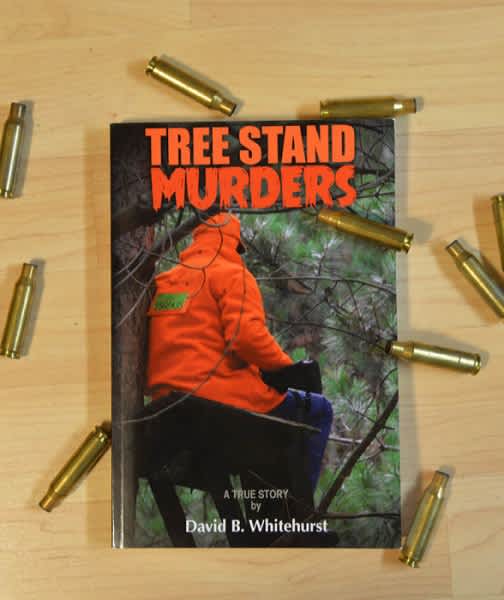New Book Looks Back at the Infamous Wisconsin “Treestand Murders”
Patrick Durkin 03.25.15

Illinois’ David Whitehurst was deer hunting northeast of Rice Lake, Wisconsin, on November 21, 2004, when he and his friends saw ambulances race by about 1:20 p.m.
Soon after, they spotted a plane flying low and slow over the forest in a systematic search. By 3 p.m. Whitehurst’s group learned eight hunters had been shot nearby. Five were dead and a manhunt was underway for the shooter. A sixth died the next day.
Whitehurst phoned home immediately to inform his wife before she heard news reports from the Blue Hills, a region he had been hunting for 25 years. By early evening, while eating at Lehman’s Supper Club in Rice Lake, Whitehurst learned the victims’ identities from the locals, including some who knew them personally.
Killed were Bob Crotteau, 42; his son Joey, 20; Jessica Willers, 27; Alan Laski, 43; Mark Roidt, 28; and Denny Drew, 55. Terry Willers, Jessica’s father, survived; as did Lauren Hesesbeck.
News of the stunning tragedy flashed worldwide by nightfall. Yes, lone deer hunters occasionally die in shooting accidents, but a deliberate mass killing? Murders just don’t happen in the deer woods; at least not until Chai Soua Vang went on this rampage.
As Whitehurst’s group retired that evening, he said someone needed to write a book about it.
“This was a major event,” he said in an interview. “It’s a story that needed to be documented for history.”
When no one took on what seemed an obvious project, Whitehurst decided to write the “true crimes” story himself. The result is Tree Stand Murders, a 194-page book available in paperback and electronically for Kindle, Nook, and iPads.
It’s Whitehurst’s first book. The retired business executive spent 30 years with the Griffin Wheel Co., a railroad wheel manufacturer, where he worked as an engineer before becoming its president, and then corporate vice president and director of the parent company, Amstead Industries Inc.
To research the book, Whitehurst attended Vang’s trial in September 2005 and eventually read more than 1,600 pages of investigators’ reports. He also interviewed the investigators, prosecutors, and defense attorneys; friends and family of the victims; as well as friends and family of Vang. Whitehurst requested an interview with Vang, but received no reply.
Vang, now 46, is serving a life-without-parole sentence—six consecutive life terms plus 70 years—in the Iowa State Penitentiary at Fort Madison. He was moved there in January 2006 from the Dodge Correctional Institution in Waupun, Wisconsin, because of security concerns.
Whitehurst hopes his book convinces readers that Vang received a fair trial and a sentence appropriate for his crimes. He also hopes it builds respect for the Hmong community, whom he considers heroic Americans for their tenacious fighting during the Vietnam War.
“I respect the Hmong people,” Whitehurst said. “I don’t respect Chai Vang or his actions. He’s a liar and scofflaw with an explosive temper. He had prior citations for trespassing and overbagging fish, and he knew it was illegal to enter private property and hunt from someone else’s treestand.”
Whitehurst’s book details Vang’s tormented life leading up to the shootings. The former California National Guardsman was fatigued from financial stress and working two full-time jobs.
He was in his third marriage when he departed St. Paul, Minnesota, at 1:30 a.m. on November 20, 2004, to hunt deer in Wisconsin with friends. His first marriage failed after he accused his wife of infidelity and pointed a loaded handgun at her. His second marriage ended after he nearly choked his wife to death for gambling away $3,000.
Whitehurst also contends the slayings weren’t racially motivated.
“Race played a role, but it was not the primary factor some media tried to make it,” he said. “Yes, the landowners were angry and yelled at him, and used some racial slurs. But they probably would have been just as angry if he’d been white. He could have kept walking, but he turned around and started shooting. Even at his trial 10 months later, he said three of them ‘deserved to die’ for the way they treated him.”
Whitehurst said the evidence and court testimony left no doubt Vang fired the first shot, that he chased down the Crotteaus as they fled, that seven of the eight victims weren’t carrying firearms, and that he coldly executed four of them (Laski, Jessica Willers, and the Crotteaus) with point-blank shots when their initial wounds didn’t kill them.
Hesesbeck and Terry Willers survived only because Vang ran out of ammunition after firing his 7.62x39mm semiauto rifle 22 times. Terry Willers was the only victim carrying a firearm, and Hesesbeck used Willers’ rifle to fire once after being shot. The others had been at their cabin and rode out unarmed on ATVs when Willers radioed from the stand site to say he was evicting a trespasser.
Tree Stand Murders is a thorough, no-frills account of a brutal killing spree. It’s not the stuff of Truman Capote (In Cold Blood) or Vincent Bugliosi (Helter Skelter), but Whitehurst does a credible job of analyzing the crime and answering questions still lingering a decade after the infamous event.

